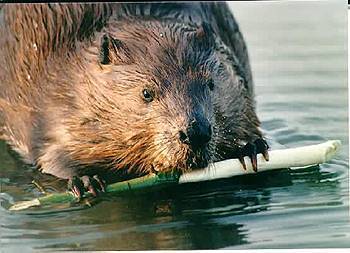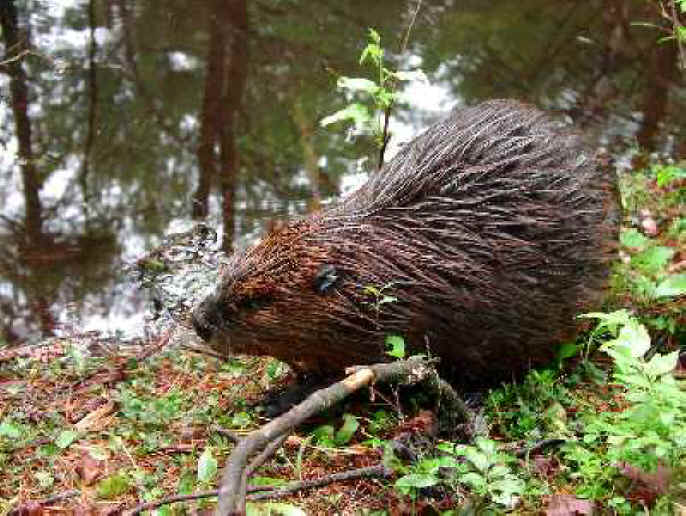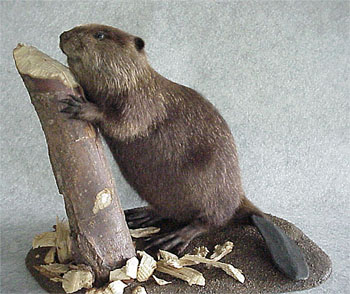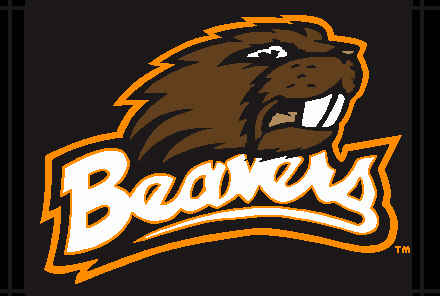  CLASSIFICATION
Kingdom: Animalia
Phylum: Chordata
Sub-Phylum- Vertebrata
Class: Mammalia
Order: Rodentia
Family: Castoridae
Genus
species: Castor canadensis
GENERAL
INFO
Beavers
are vertebrate deuterostomes. They are eucoelomates and have closed
circulation. They have an endoskeleton and are also endothermic. Beaver's
fur is dark brown. It has a round head, a large flat paddle-shaped tail
and webbed hind feet. The un-webbed front paws are smaller, with claws.
The adult beaver weighs about 44 pounds, but can be as large as 77 pounds.
It is about 12 in tall, and its tail is about 10 in long. The beaver
is the largest rodent in North America, and one of the largest in the
world. Adult American Beavers do not
migrate. The current Beaver population is estimated at 10-15 million. Some
people think that beavers are harmful but others think they are good. People may become angry when beavers cut down their trees
or when their dams cause flooding. Overall, beavers help create habitat
for a lot of animals and also keep the water clean and healthy.

SPECIAL FEATURES:
Beavers have a large
tail that can be used as a rudder in the water. They have webbed feet to
aid them in swimming. Beavers have five toes with strong nails are found
on the hind feet, including a unique split toenail on one toe which serves
the beaver as a comb for grooming. Beavers have a nictitating membrane over
their eyes that enable them to see underwater. Their ears and nose have
valves that close when ever they submerge underwater. Two upper and two
lower incisor teeth make up most of the front of a beaver's mouth.
The upper incisors overlap the lower incisors, and friction from chewing
causes the teeth to self-sharpen to chisel sharpness.
HABITAT
American Beavers are
located in Canada, most of the United States excluding Florida and
the deserts of the southwest. Beavers mostly live by rivers, streams,
ponds, and lakes. They are one of the few animals that change their environment
in order to provide themselves living space and protection.
Beavers build dams that change the course of streams and create ponds.
They build dams and lodges using sticks, bark , mud, and logs. The
presence of pointed tree stumps is a good indication that there are
beavers living nearby.
To create a habitat, beavers build a dam in a stream, flooding an area of
the woods and creating a pond in which the beaver can build a lodge. This
beaver lodge or den is located away from shore and has an underwater
entrance. This makes it difficult for most predators to enter the lodge.
In winter, the water around the lodge usually freezes, protecting the
beaver almost completely. Some beavers live by rivers and do not need to
build dams. Instead, they live in burrows that they build on the river
bank The American Beaver is located in parts of South Dakota.

DIET
Beavers are mostly herbivores.
Most of the beaver's diet
is made up of tree bark and the soft tissue that grow under the bark of a
tree. They especially like the bark of willow, maple, birch, aspen,
cottonwood, beech, poplar, and alder trees. Beavers also eat other
vegetation like roots and other water plants. The beaver has a specialized
digestive system that helps it digest tree bark.

REPRODUCTION
Beavers are monogamous which means
they only have one life partner. If that partner dies then the beaver will
search for a new one. The Beaver breeding season is January through
February. The period where the embryo develops inside the uterus lasts for
about four months. The average litter size is 4 kits. They are born fully
furred and learn to swim after birth. Their eyes are open at birth and
will go underwater shortly after being born. Beavers live in family colonies. The female is
the found of the colony and breeds only once a year. When young beavers
reach a certain age, they must leave the family and build their own
family. Some Beavers have been reported to travel as far as 147 miles away
from their parents in order to start their own. Beavers care for their
young by supplying them with food. Since young beavers donít travel far
from the den, food is supplied by the family.
HUMAN
IMPACT
Beavers have been affected by humans in many negative ways. They are
considered pests by some people so Beavers are
trapped. These animals are often trapped for their fur. During the
early 19th century, trapping eliminated this animal from most of its
original range. The beaver furs were used to make clothing and top-hats.
Much of the early exploration of North America was driven by the quest for
this animal's fur. Native peoples and early settlers also ate this
animal's meat. The current Beaver population should be ten times what it
is today.
WEB LINKS
http://animaldiversity.ummz.umich.edu/site/accounts/information/Castoridae.html
SOURCES:
http://www.mass.gov/dfwele/dfw/dfwimg/dfw_beaver_photo.jpg
http://valuecarpetonline.com/oregon-state-dm.jpg
http://www.ktil-kmbd.com/images/osu_logo_s.jpg
http://www.nsrl.ttu.edu/tmot1/castcana.htm://imnh.isu.edu
http://www.enchantedlearning.com/subjects/mammals/Beaver.shtml
http://en.wikipedia.org/wiki/American_Beaver

| 



